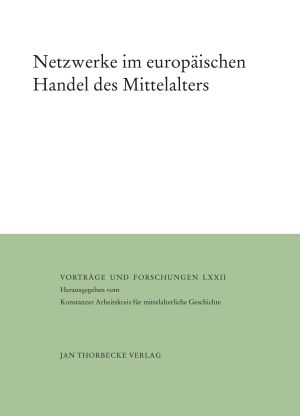Archives

Vorträge und Forschungen: Fürsten und Finanzen im Mittelalter
Vol. 95 (2024)
(for now only table of contents)
»Princes and lords […] can achieve nothing, if they have no money.« Hardly any sentence sums up the motivation and justification for dealing with »Princes and Finances in the Middle Ages« as succinctly as this remark by Levold of Northof in his mirror for princes of 1357/58. This conference volume addresses the research desideratum of a history of princely finances in the Middle Ages. It does not only address the sources of finance and debts of secular princes but also extends the view to ecclesiastical princes, princesses, and princely widowers, to mirrors for princes and to the literature of the time in general, as well as to the Chinese emperor. Princely financial history taking gender research into account, in an interdisciplinary approach as well as in an intercultural comparison – this has never been done before in one volume besides the treatment of »classical« fields of princely history.
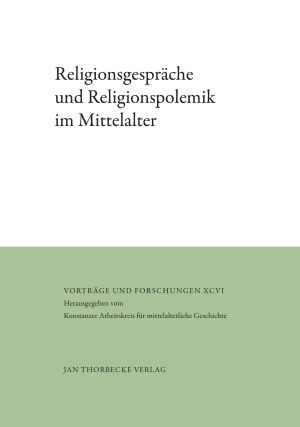
Vorträge und Forschungen: Religionsgespräche und Religionspolemik im Mittelalter
Vol. 96 (2023)
(for now only table of contents)
The Christian-based European realms of the Middle Ages were by no means religiously homogeneous. Contact, cooperation and conflict with other denominations and religions were handled intellectually and pragmatically. Dialogic texts, which collected arguments meant to secure one’s own position and convince the opposing side, played a central role among the media dealing with other religions. The contributions to this interdisciplinary anthology discuss such imagined religious conversations,
as well as references to real discussions on questions of faith, late medieval disputations with representatives of Jewish communities, and everyday conversations between Christians and Jews. Literary and social relationships between Christian and Jewish protagonists, the preoccupation with Islam in Spain, Christian Vitae of Mohammed and the confessional mix in late medieval Venetian Crete are examined.

Vorträge und Forschungen: Klangräume des Mittelalters
Vol. 94 (2023)
(vorerst nur Inhaltsverzeichnis)
Die Sinne haben in der jüngeren Mittelalterforschung Konjunktur. Immer häufiger werden sie zu Gegenstand kulturgeschichtlicher Studien, die noch kaum erforschte, hoch anregende Fragen aufwerfen: In welchem Maße und auf welche Weisen waren das Sehen und Hören, das Schmecken, Tasten und Riechen kulturell kodiert? Welche gesellschaftlichen Funktionen erfüllten Bilder, Geräusche, Gerüche? Im Fokus der dreizehn Aufsätze dieses Sammelbandes steht das weite Feld der mittelalterlichen Akustik. Die Autorinnen und Autoren erforschen zeitgenössische Haltungen zu Lärm und Schweigen; sie untersuchen den Einsatz von Geräuschen als Mittel der Repräsentation, der gesellschaftlichen Ordnung, der Anziehung und Abstoßung; und sie analysieren, wie im Mittelalter die Erzeugung und Wahrnehmung von Klängen besprochen, beschrieben, gemalt, gedeutet wurden. Die Beiträge liefern Einblicke in entfernte Räume – von Byzanz im Osten bis zur Iberischen Halbinsel im Westen, von Mitteleuropa bis in den Nahen Osten. Sie untersuchen Akustik aus der Perspektive unterschiedlicher historischer Teildisziplinen – der Geschichtswissenschaft und der Rechtsgeschichte, der Literaturwissenschaft, der Kunst- und der Musikgeschichte. Dadurch entsteht eine multidimensionale Bestandsaufnahme eines noch jungen Forschungsfeldes mit hohem Erkenntnispotential.

Vorträge und Forschungen: Stellvertretung im Mittelalter Konzepte, Personen und Zeichen im interkulturellen Vergleich
Vol. 88 (2023)
(vorerst nur Inhaltsverzeichnis)
Im Mittelalter war »Stellvertretung« zum einen als legitimierendes Prinzip sakraler Herrschaft (Stellvertretung Gottes/Christi auf Erden) von Bedeutung und zum anderen als notwendiges Herrschaftsinstrument im politischen und kirchlichen, aber auch wirtschaftlichen, rechtlichen und sozialen Leben nahezu omnipräsent. Dennoch ist dieses Phänomen in der historischen Forschung – im Unterschied zur theologischen und
rechtshistorischen – bisher nur punktuell untersucht worden. Vor allem fehlt eine Auseinandersetzung mit den Konzepten sowie den begrifflich und inhaltlich zu unterscheidenden Formen von Stellvertretung. Mit dem vorliegenden Band sollen nun im Rahmen eines interkulturellen Vergleichs Konzepte, Personen und Zeichen von vornehmlich religiös konnotierter beziehungsweise im geistlichen Bereich angesiedelter Stellvertretung in den christlichen West- und Ostkirchen, dem Islam, dem Mongolenreich und Japan untersucht werden.
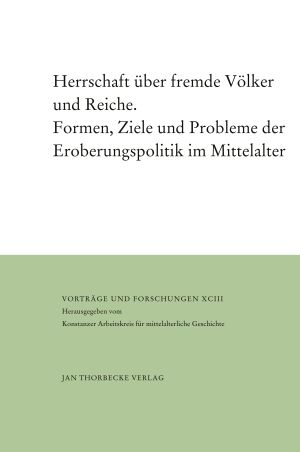
Vorträge und Forschungen: Herrschaft über fremde Völker und Reiche. Formen, Ziele und Probleme der Eroberungspolitik im Mittelalter
Vol. 93 (2022)
This volume treats conquests for the first time as a phenomenon that decisively shaped political history, the formation of spaces of dominion and power techniques as well as the development of politically and culturally determined identities in the Middle Ages. Its chapters look, often with a comparative approach, at the most important European conquests from late antiquity to the 15th century and traces motives, aims and means with which the conquerors, from Theoderic to Charlemagne to Edward I, from the Normans in southern Italy to the Teutonic Order, established their rule over foreign peoples and dealt with their resistance. Special attention is also paid to the justification of conquests, i. e. to their religious charging in Byzantium and in the seizure of non-Christian territories, but also to ambivalent legitimation in law and literature. In this way, a multifaceted picture of practices of medieval conquests and the discourses involved emerges.
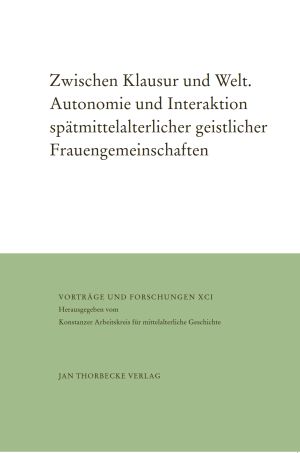
Vorträge und Forschungen: Zwischen Klausur und Welt. Autonomie und Interaktion spätmittelalterlicher geistlicher Frauengemeinschaften
Vol. 91 (2022)
Religiöse Frauengemeinschaften eröffnen faszinierende Einsichten in die kulturelle, intellektuelle und soziale Entwicklung im Mittelalter. In der Ordensforschung sind Frauen bisher dennoch vor allem als »pastorales Problem« in Erscheinung getreten. Die Erforschung der weiblichen Religiosen bietet deshalb als die vielleicht größte Forschungslücke der aktuellen Geschichtswissenschaft ein enormes Forschungspotenzial. Der vorliegende Band arbeitet mit interdisziplinärem Ansatz die zentrale Rolle religiöser Frauen, ihrer Visionen und Lebensentwürfe für die Entwicklung der vormodernen Gesellschaft heraus. Die vielschichtigen Beziehungen und Interdependenzen zwischen dem ›Sonderraum‹ Kloster und der Laiengesellschaft erhellen deshalb in besonderer Weise Neuansätze oder Wandel der mittelalterlichen Gesellschaft.
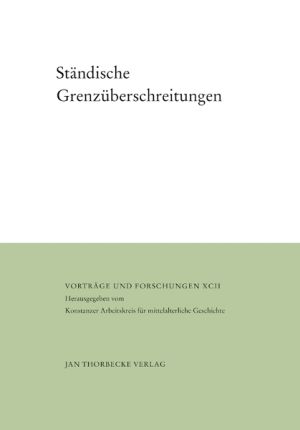
Vorträge und Forschungen: Ständische Grenzüberschreitungen
Vol. 92 (2021)
Going beyond Adalbero of Laon’s early 11th century tripartite division
of medieval society, this volume examines transitions between social estates,
particularly the temporary and permanent transgressions of legally,
symbolically or performatively defined estate boundaries in the later
Middle Ages. Instead of the »classical« problem of burghers ascending into nobility, this book focuses on transitions in other directions, for instance members of the clergy entering into aristocracy, and upon examples of one estate’s symbols being appropriated by another. The chapters treat such phenomena systematically by inquiries into the reasons, timing and geography of the estate boundary transgressions. Contemporaneous selfconceptions and opposing perceptions of how social boundaries transitioned and were transgressed are central to this volume.
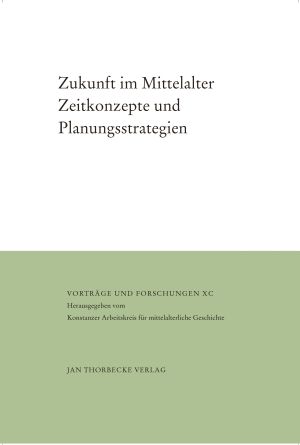
Vorträge und Forschungen: Zukunft im Mittelalter. Zeitkonzepte und Planungsstrategien
Vol. 90 (2021)
Medieval ideas about the future have largely been neglected by modern research, with the exception of ideas about the end of time and the apocalypse. Without neglecting these important transcendental perspectives, the contributions to this volume demonstrate the existence of medieval ideas about the future (and ensuing practices) that are characterised by their secular orientation in the medium term. Analysing economic practices, religious conceptions and their practical implementation, prognostications, and explicit reflections on the future in text and image, this volume demonstrates that medieval societies were strongly interested in the midterm future and not limited to the dichotomy between the immediate tomorrow and the preparation for eternal salvation.
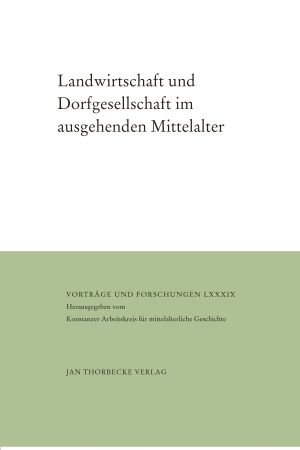
Vorträge und Forschungen: Landwirtschaft und Dorfgesellschaft im ausgehenden Mittelalter
Vol. 89 (2020)
Agricultural economy and the village were decisive for the way most people in Europe lived in the Middle Ages and Early Modern Times. Research into the rural world is therefore of fundamental importance. The spatial focus of the present volume is Central Europe and the chronological one is the late Middle Ages. The period around 1500 in particular, with its dense sources, now opens up rewarding research perspectives for rural areas. This applies not only to classical areas of agricultural history such as the regionally very different agricultural constitutions and the forms of agricultural production: arable farming and animal husbandry as well as special crops such as viticulture. In addition central problems such as the environment and climate, the market orientation, the organisation and everyday life of the village society, the rural life in art and other central issues can also be examined more closely in this period. Agricultural history has proved to be a fruitful field of work for medieval research for regional history. The present volume offers numerous new results, but also provides a variety of suggestions for further research into agricultural history and rural life in the late Middle Ages.

Vorträge und Forschungen: Kleine Welten. Ländliche Gesellschaften im Karolingerreich
Vol. 87 (2019)
The volume paints a new picture of rural societies in the Carolingian Empire. It observes the coexistence of people in spaces that were smaller than the county and the diocese. How were these "small worlds" connected to the larger politics? How were goals of the ruler and the elites conveyed here? And how were the concerns of the local people brought back to the court? The book sheds light on the types of sources that can be used to observe local societies can be observed (archaeology, formulae, charters, hagiography, polyptycha).
A second part is devoted to the mediators between the court and the regional elites as well as the local level (such as priests and secular officials). The third part contains regional studies on Bavaria, the Middle Rhine, Alemannia, Tuscany, and - looking beyond the Carolingian Empire - Brittany and northern Spain.
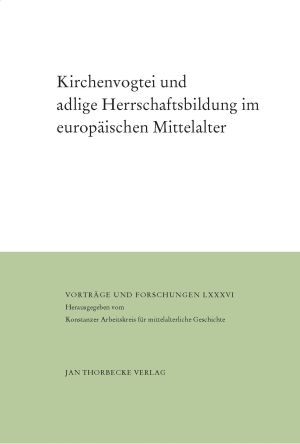
Vorträge und Forschungen: Kirchenvogtei und adlige Herrschaftsbildung im europäischen Mittelalter
Vol. 86 (2019)
The bailiwick in its various forms is one of the fundamental structural elements of the medieval of the medieval order of rulers. In the Europe-wide process of the emergence of sovereignty Latin "advocatia" - played a role in a variety of contexts. role. Of particular interest is the church bailiwick in the context of noble rule formation.
However, in spite of an almost unmanageable abundance of individual studies in the German-speaking of individual studies, this is still one of the topics of medieval and regional research on medieval and regional history, which lacks a supraregional overview. With the volume is intended to attempt this comparative view in a European context. European framework. This seems all the more attractive because the topic of ecclesiastical bailiwicks has recently interest in the subject of ecclesiastical bailiwicks in Western Europe.
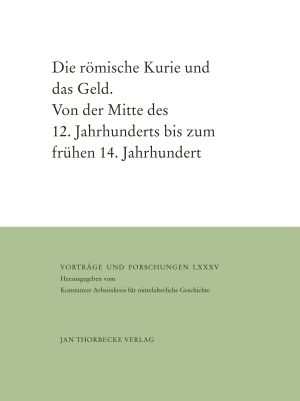
Vorträge und Forschungen: Die römische Kurie und das Geld. Von der Mitte des 12. Jahrhunderts bis zum frühen 14. Jahrhundert
Vol. 85 (2018)
The »greed for money« of the Roman Curia has been a widespread cliché and topic of satire since the late 11th century. This is an indicator for the various efforts of the papacy to finance the continuously growing apparatus of the Curia due to the fact that the usual income arising from the Lands of St Peter was no longer enough to cope with externally imposed tasks. Via articles in German, French, and English (and a translation from Italian), the 14 proven experts in this anthology deal with the income and expenditures of the headquarters of the Latin Christianitas and their wide claim to power. The range of subjects is quite broad: numismatic topics, the heterogeneous sources of financing of the papacy, the role of merchants-bankers from Rome, Siena, Florence and other municipalities of central and northern Italy, the finances of the cardinals, the high costs of the legations, the financing of the policy in the debate concerning the kingdom of Sicily, the canonical prohibition on receiving interest, and much more. The result of the research findings is that the early capitalistic monetary economy of the Middle Ages registered a considerable development boost caused by the papacy and the Roman Curia.
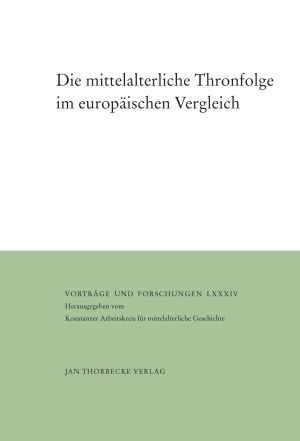
Vorträge und Forschungen: Die mittelalterliche Thronfolge im europäischen Vergleich
Vol. 84 (2017)
During the last few years, our approach to the Middle Ages has changed altogether. Thus the European Middle Ages are rather regarded as a self-contained era instead of simply as a prelude to Modernity. In a way, this can be referred to as an anthropological turn in Medieval Studies with a major impact on Constitutional History. Current research increasingly focuses on personal relations. However, it is controversial as to what extent contemporaries already distinguished between the king’s public function as a permanent representative of a community and his condition or quality of being human and thus mortal. This volume focuses on different dimensions of royal succession – such as the queen’s role, the function of the ruler’s sacred status and the phenomenon of disputed royal successions – as crucial aspects to the constitution of medieval realms.

Vorträge und Forschungen: Maritimes Mittelalter. Meere als Kommunikationsräume
Vol. 83 (2016)
research. To date, the history of seas and oceans in the Middle Ages has generally been reduced to that of specific aspects such as the German Hansa, the Vikings etc – or it has been relegated to certain sub-disciplines such as economic history. Seen from the perspective of comparative history however, it is imperative not to understand the sea as a detached field of historical research, but rather as an integral part of medieval people’s experiences and mind frames. As such, the maritime world was not a separated geographical zone, but rather inextricably interwoven into medieval history at such. This volume comprises articles on European seas (the North Sea, the Baltic, the Black Sea) as well as on intercontinental seascapes such as the Mediterranean, the Atlantic and the Indian Ocean. They present important new contributions from the perspective of Scandinavian, Islamic, Indian and Medieval Studies. This collection will point out new paths of research, not the least due to a change in perspective – from a terrestrial to a maritime point of view – that provides unusual insights.
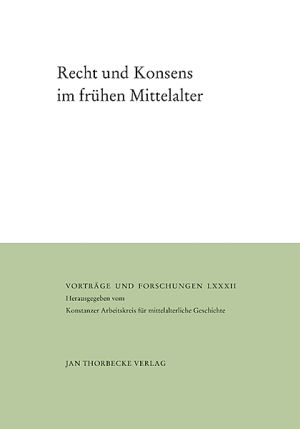
Vorträge und Forschungen: Recht und Konsens im frühen Mittelalter
Vol. 82 (2017)
Was there consensual rulership and political participation of elites in the Early Middle Ages? Yes indeed, and especially in the realm of law. Since the legal and political unity of the Roman Empire had come to an end in the fifth century, the law codes of the post-Roman successor states had to be built on the consensus of its political elites. Conciliar decrees – thought of as inspired by the holy spirit – were based on the consensus of its participants, too. The common view of the migration period as a time of struggle and chaos is modified in this volume by the observation and analysis of several political fields, in which consensus worked to establish a new legitimation of law and rulership. By transforming coercion into self-obligation consensus had an integrating effect on the successor states, because it worked notwithstanding ethnic and religious differences.
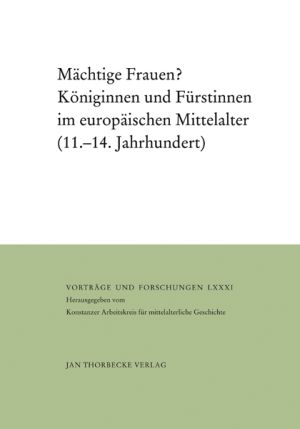
Vorträge und Forschungen: Mächtige Frauen?
Vol. 81 (2015)
In recent decades, women of the higher nobility ruling and exercising power in the medieval period have increasingly moved to the fore of international research. Attention was paid especially to those queens whose family backgrounds and favourable structural circumstances enabled them to emerge as queens regnant or to rule on behalf of their absent husbands or under-aged sons. These conference proceedings aim to broaden the international research discourse by juxtaposing queens and princesses in the various kingdoms and regions of Europe during the High and Late Middle Ages. Basic considerations on the significance of power in the medieval period are followed by papers on queens and princesses on the Iberian Peninsula, in the principalities of Outremer, in England, France, Upper Italy, the Habsburg Southwest of the Holy Roman Empire and in Tyrol. Specific consideration was also given to the coronation ordines for empresses and queens, to papal epistles to queens and princesses, and to the significance of ecclesiastical princesses ruling from the 11th to the 14th century.
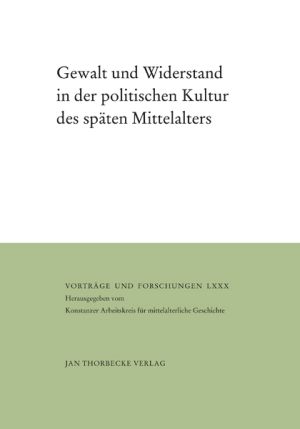
Vorträge und Forschungen: Gewalt und Widerstand in der politischen Kultur des späten Mittelalters
Vol. 80 (2015)
Physische Gewalt war Bestandteil der Ausübung von Macht und Gerichtsgewalt im Mittelalter. Als Androhung präsent, konnte auf sie demonstrativ verzichtet oder ihre Anwendung mit expressiver Deutlichkeit vorgenommen werden. Indem der Umgang mit Gewalt und die Legitimität von Herrschaftsausübung wechselseitig aufeinander bezogen blieben, spiegelte sich die Gewaltpraxis in Formen des Widerstands. Die Spezifik der Gewaltausübung gehört zu einer besonderen politischen Kultur, die sich von der modernen deutlich unterscheidet. Nicht um eine herrschaftstheoretische Definition von Gewalt geht es den dreizehn hier versammelten Beiträgen, sondern um die exemplarische Beschreibung von aussagekräftigen Einzelfällen und den internationalen wie interkulturellen Vergleich. Letzterem dienen Beispiele aus der Geschichte Europas und des arabisch-islamischen Raumes.
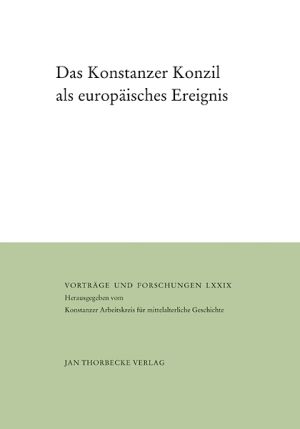
Vorträge und Forschungen: Das Konstanzer Konzil als europäisches Ereignis
Vol. 79 (2014)
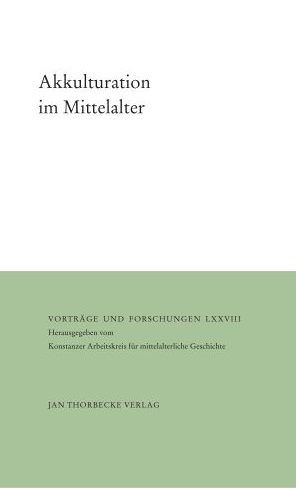
Vorträge und Forschungen: Akkulturation im Mittelalter
Vol. 78 (2014)
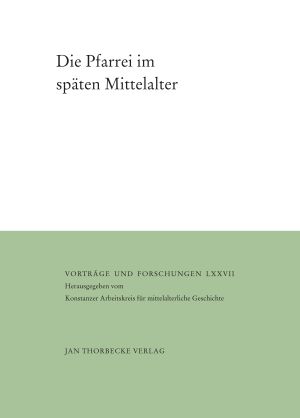
Vorträge und Forschungen: Die Pfarrei im späten Mittelalter
Vol. 77 (2013)
Im späten Mittelalter war die Pfarrei für die meisten Menschen eine alltägliche Erfahrung. Die zahlreichen Pfarrkirchen in Stadt und Land fungierten nicht nur als Stätten von Gottesdienst und Seelsorge, sondern waren auch Schnittstellen zu vielen weltlichen Lebensbereichen. Die Beiträge dieses Bandes betrachten die Pfarrei deshalb aus ganz unterschiedlichen weltlichen wie kirchlichen Perspektiven und bieten viele neue Forschungsergebnisse zum Verhältnis von Kirche und Welt in den Jahrhunderten vor der Reformation.
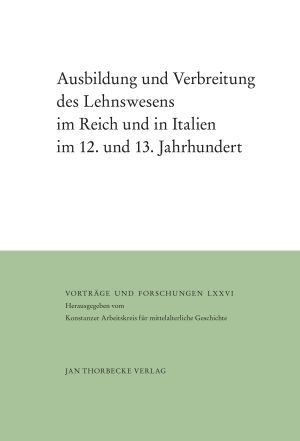
Vorträge und Forschungen: Ausbildung und Verbreitung des Lehnwesens im Reich und in Italien im 12. und 13. Jahrhundert
Vol. 76 (2013)
Ausbildung und Verbreitung des Lehnwesens im Reich und in Italien im 12. und 13. Jahrhundert
Angesichts der scheinbar gesicherten Vorstellung eines bereits im 9. Jahrhundert von den Karolingern auf breiter Basis als Herrschaftsmittel eingesetzten Lehnswesens, das im 10. bis 13. Jahrhundert seine klassische Blütezeit erlebt habe, wirkte das 1994 erschienene Buch von Susan Reynolds »Fiefs and Vassals. The Medieval Evidence Reinterpreted« wie ein Schock. Ihrer Meinung nach hätten bisherige Historiker eine erst im 16. Jahrhundert durch juristische Systematisierung entstandene Vorstellung von einer engen Verknüpfung von Vasallität und Lehen auf die Verhältnisse des Früh- und Hochmittelalters übertragen. Das Buch von Susan Reynolds löste eine internationale Debatte um eine Neubewertung des Lehnswesens aus. Trotz zahlreicher Einwände im Detail blieb die Hauptthese bestehen und wurde auf mehreren Konferenzen diskutiert. Die Tagung »Ausbildung und Verbreitung des Lehnswesens im Reich und in Italien im 12. und 13. Jahrhundert« im April 2011 auf der Insel Reichenau setzte die Diskussion über eine Neubewertung des Lehnswesens fort und nahm dabei besonders das 12. und das 13. Jahrhundert in den Blick. Führende Mediävisten und Rechtshistoriker hinterfragen in dem vorliegenden Band gesicherte Handbuchmeinungen vom Lehnswesen im Umfeld des Papsttums, in Oberitalien und im Reich und machen neue Deutungen plausibel.
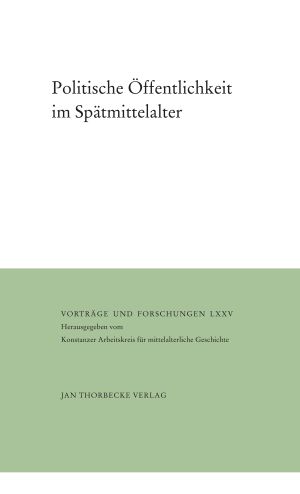
Vorträge und Forschungen: Politische Öffentlichkeit im Spätmittelalter
Vol. 75 (2011)
Politische Öffentlichkeit im Spätmittelalter
Öffentlichkeit ist nicht erst in der Moderne, sondern war bereits im europäischen Spätmittelalter ein Instrument der Informationsverbreitung in der Gesellschaft. Auch zeremonielle Inszenierungen an den Höfen waren Teil der politischen Kommunikation, mit der man sich über gegenseitige Ansprüche und Erwartungen austauschte und die eigenen Interessen zur Geltung brachte. Öffentlichkeit war konstitutiv für die Repräsentation politischen Handelns. Erst indem politische Akte, Verlautbarungen, Begegnungen und Entscheidungen öffentlich gemacht wurden, konnte es ihnen gelingen, den für ihre Umsetzung notwendigen Konsens, Zustimmung und Gefolgschaft zu finden. Politische Öffentlichkeit wurde damit zu einer entscheidenden Grundlage für die Stabilität und Geltung der gesellschaftlichen und herrschaftlichen Ordnung. Das Publikum bei Inszenierungen, die Adressaten der Akte politischen Handelns und Empfänger publizistischer und propagandistischer Veröffentlichungen waren häufig nicht identisch, sondern jeweils besondere „Teil-Öffentlichkeiten“ innerhalb der zeitgenössischen Gesellschaft. Die Beiträge des Bandes untersuchen die politische Öffentlichkeit des Spätmittelalters in verschiedenen disziplinären, medialen und funktionalen Kontexten und verdichten die vorgetragenen Forschungsergebnisse zu einer neuartigen Geschichte der politischen Kultur.

Vorträge und Forschungen: Böhmen und seine Nachbarn in der Přemyslidenzeit
Vol. 74 (2011)
Böhmen und seine Nachbarn in der Přemyslidenzeit
Die gesammelten Aufsätze zum Thema Böhmen und seine Nachbarn in der Přemyslidenzeit versuchen zu klären, wie es in Böhmen unter der rund vier Jahrhunderte umfassenden Herrschaft der Přemysliden-Dynastie (ca. 900 bis 1305) zu einer Reichsbildung kam, die einerseits die Grundlagen zu einer selbständigen Staatsbildung schuf und die sich andererseits in einem engen Interdependenzverhältnis zu den benachbarten Nationen vollzog. Die Felder, auf denen dies untersucht wird, sind die politischrechtlich-soziale Verfaßtheit des Landes, die Rolle der Kirche und der Kultbeziehungen, die Orientierung des Adels, die von Hegemoniebestrebungen der Přemyslidenfürsten gegenüber den polnischen und ungarischen Nachbarn geprägten »Außenbeziehungen« sowie das Verhältnis Böhmens und seiner Herrscher zu Kaiser und Reich. Darüber hinaus galt es, den wissenschaftspolitischen Versuch zu wagen, eine Diskursfähigkeit, wenn möglich eine Verständigung herzustellen zwischen Gelehrten, deren Weltbild und historiographische Tradition sich in den letzten beiden Jahrhunderten zunächst unter nationalstaatlicher, seit dem Ende des Zweiten Weltkriegs eher unter westlich-‚bürgerlicher’ resp. östlich-marxistischer Prämisse in sehr unterschiedlicher Richtung entwickelt hatten und die unter dem Signum eines vereinten Europa zu einer Neuorientierung zu kommen suchen.

Vorträge und Forschungen: Beiträge zur Kulturgeschichte der Gelehrten im späten Mittelalter
Vol. 73 (2010)
Beiträge zur Kulturgeschichte der Gelehrten im späten Mittelalter
Gelehrte zeichnen sich nicht nur durch das Wissen aus, über das sie verfügen, sondern ebenso durch besondere Arten zu denken, zu argumentieren und zu leben. Sie prägen einen eigenen Habitus aus, der ihnen in ihrer Umwelt gleichermaßen Respekt verschafft und Anlass zu Kritik bietet. Auch wenn es bereits in den Jahrhunderten zuvor durchaus gelehrte Einzelpersonen gab, erlangt der kulturelle Typus des Gelehrten mit dem Aufschwung der wissenschaftlichen Schulen während des 12. Jahrhunderts eine Bedeutung, die er vormals zuletzt in der Antike gehabt hatte. Der Konstanzer Arbeitskreis versammelte während einer seiner Tagungen die einschlägigen Experten der spätmittelalterlichen Gelehrtenkultur und legt nun einen Band vor, der die lebensweltliche Bedeutung des "höheren" Wissens dokumentiert. Die Beiträge behandeln das literarische und ikonographische Bild von Gelehrten, ihr Familienleben, ihren Bücherbesitz und ihre Patronage-Strategien. Die Lebensentwürfe christlicher werden mit denen jüdischer und muslimischer Gelehrter verglichen.

